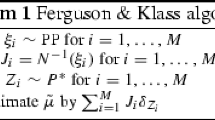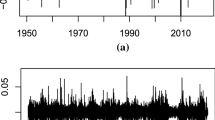Abstract
Robustness of large quantile estimates to the largest element in a sample of methods of moments (MOM) and L-moments (LMM) was evaluated and compared. Quantiles were estimated by log-logistic and log-Gumbel distributions. Both are lower bounded and two-parameter distributions, with the coefficient of variation (CV) serving as the shape parameter. In addition, the results of these two methods were compared with those of the maximum likelihood method (MLM). Since identification and elimination of the outliers in a single sample require the knowledge of the sample’s parent distribution which is unknown, one estimates it by using the parameter estimation method which is relatively robust to the largest element in the sample. In practice this means that the method should be robust to extreme elements (including outliers) in a sample.
The effect of dropping the largest element of the series on the large quantile values was assessed for various “coefficient of variation (CV) / sample size (N)” combinations. To that end, Monte-Carlo sampling experiments were applied. The results were compared with those obtained from the single “representative” sample, (the first order approximation), i.e., consisting of both the average values (Ex i ) for every position (i) of an ordered sample and the theoretical quantiles based on the plotting formula (PP).
The ML-estimates of large quantiles were found to be most robust to largest element of samples except for a small sample where MOM-estimates were more robust. Comparing the performance of two other methods in respect to the large quantiles estimation, MOM was found to be more robust for small and moderate samples drawn from distributions with zero lower bound as shown for log-Gumbel and log-logistic distributions. The results from “representative” samples were fairly compatible with the M-C simulation results. The Ex-sample results were closer to the M-C results for smaller CV-values, and to the PP-sample results for greater CV values.






Similar content being viewed by others
References
Ahmad MI, Sinclair CD, Werritty A. (1988) Log-logistic flood frequency analysis. J Hydrol 98:205–224
Cunnane C (1978) Unbiased plotting positions – a review. J Hydrol 37(3/4):205–222
Cunnane C (1989) Statistical distributions for flood frequency analysis. WMO-No.718, Operational Hydrology Report No.33, Geneva, Switzerland, pp 73+6 Appendices
Fisz M (1967) Rachunek prawdopodobieństwa i statystyka matematyczna. (Probability calculus and mathematical statistics), PWN,
Greenwood JA, Landwehr JM, Matalas NC, Wallis JR (1979) Probability weighted moments: Definition and relation to parameters of several distributions expressible in inverse form. Water Resour Res 15:1049–1054
Heo JH, Salas JD (1996) Estimation of quantiles and confidence intervals for log-Gumbel distribution. Stochast. Hydrol. Hydraul 10:187–207
Hosking JRM (1986) The theory of probability weighted moments. Research Report RC12210. IBM Research Division, Yorktown Heights, NY
Hosking JRM, Wallis JR (1987) Parameter and quantile estimation for the generalized Pareto distribution. Technometrics 29:339–349
Hosking JRM, Wallis JR (1997) Regional Frequency Analysis, An approach based on L-moments. Cambridge Univ Press, pp224
Hosking JRM, Wallis JR, Wood EF (1985) Estimation of the generalized extreme-value distribution by the method of probability-weighted moments. Technometrics 27:251–261
Kaczmarek Z (1977) Statistical methods in hydrology. USGS, pp 205–209
Klemeš V (2000) Tall tales about tails of hydrological distributions. II. J of Hydrol Eng 5(3):232–239
Kuczera G (1982) Robust flood frequency models. Water Resour Res 18(2):315–324
Landwehr JM, Matalas NC, Wallis JR (1979) Estimation of parameters and quantiles of Wakeby distributions. Water Resources Research 15:1961–1979
Landwehr JM, Matalas NC, Wallis JR (1980) Quantile estimation with more or less floodlike distributions. Water Resour Res 16(1):547–555
Rao AR, Hamed KH (2000) Flood Frequency Analysis. CRC Press, Boca Raton, USA, pp350
Robson A, Reed D (1999) FEH 3: Statistical procedures for flood frequency estimation. Ch.15. Institute of Hydrology, Wallingford, UK
Rowinski P, Strupczewski WG, Singh VP (2002) A note on the applicability of log-Gumbel and log-logistic probability distributions in hydrological analyses: I. Known pdf. Hydrol Sc J 47(1):107–122
Strupczewski WG, Singh VP, Weglarczyk S (2002) Asymptotic bias of estimation methods caused by the assumption of false probability distribution. J Hydrol 258(1–4):122–148
Vogel RM, Fennessey NM (1993) L moment diagram should replace product moment diagrams. Water Resour Res 29(6):1745–1752
Author information
Authors and Affiliations
Corresponding author
Rights and permissions
About this article
Cite this article
Strupczewski, W.G., Kochanek, K., Weglarczyk, S. et al. On robustness of large quantile estimates of log-Gumbel and log-logistic distributions to largest element of the observation series: Monte Carlo results vs. first order approximation.. Stoch Environ Res Ris Assess 19, 280–291 (2005). https://doi.org/10.1007/s00477-005-0232-x
Published:
Issue Date:
DOI: https://doi.org/10.1007/s00477-005-0232-x




